OHS6205 Project: Chemical Hazards and Risk Assessment in Perth Plant
VerifiedAdded on 2022/09/18
|14
|4327
|20
Report
AI Summary
This report presents a risk assessment of chemical hazards, specifically focusing on the use of bleach in the Alkimos Waste Water Treatment Plant in Perth, Western Australia. It identifies potential hazards, including exposure to chlorine and sodium hypochlorite, and assesses the associated risks to workers' health, such as skin and respiratory irritation. The report details the background of the company, the chemical composition of bleach, and the adverse health effects of exposure. It includes figures illustrating the water treatment process and the impact of bleach. The study identifies key risk indicators like fading clothes, coughing, and respiratory distress. It also analyzes the control processes, recommends improvements, and emphasizes the importance of safety regulations, training, and organizational culture to mitigate these risks. The report highlights the potential for mixing bleach with other chemicals, leading to toxic reactions, and concludes with recommendations for implementing effective control measures to protect worker safety.

Running head: CHEMICAL HAZARDS
Chemical Hazards
Name of the Student
Name of the University
Author Note
Chemical Hazards
Name of the Student
Name of the University
Author Note
Paraphrase This Document
Need a fresh take? Get an instant paraphrase of this document with our AI Paraphraser
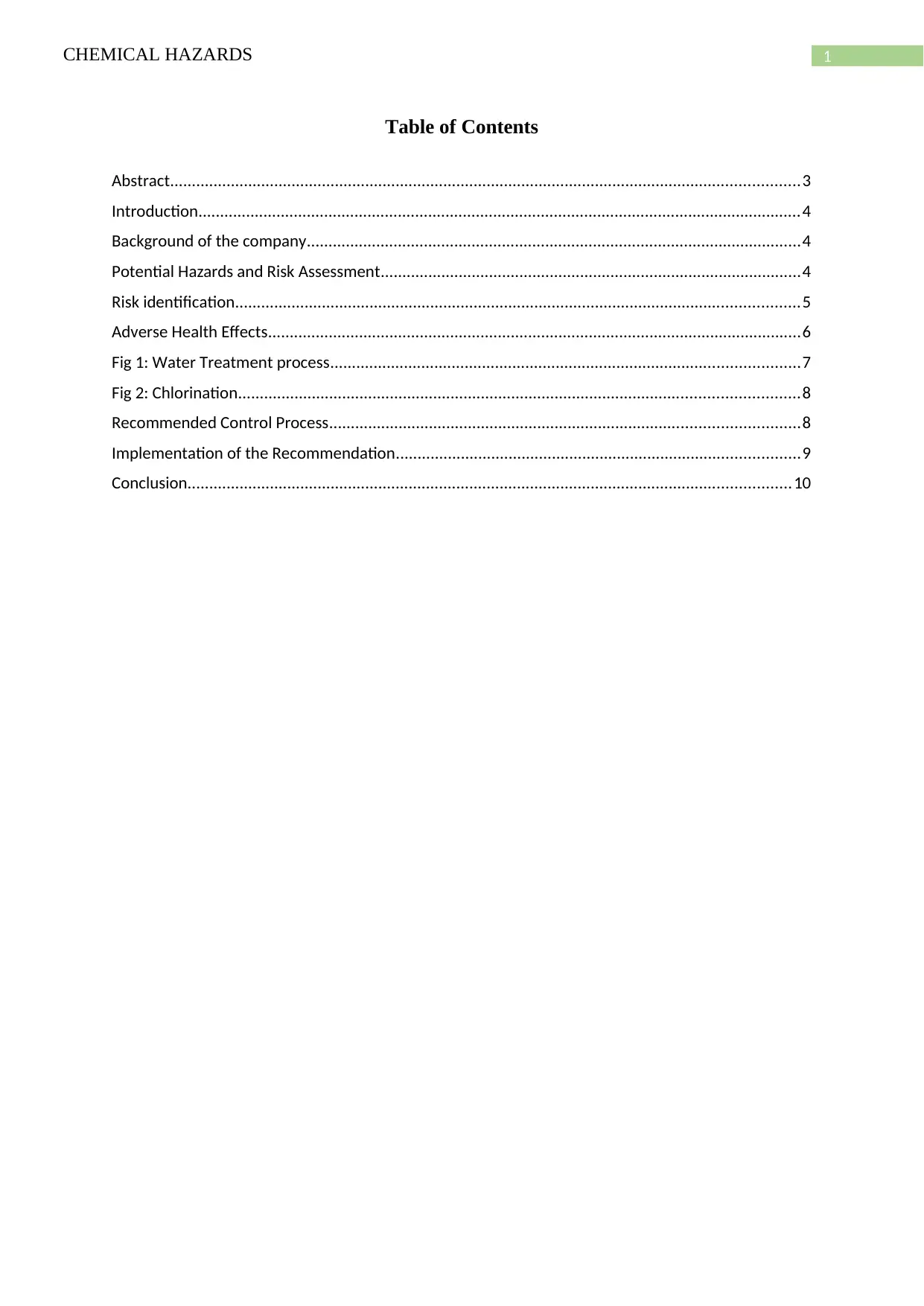
1CHEMICAL HAZARDS
Table of Contents
Abstract.................................................................................................................................................3
Introduction...........................................................................................................................................4
Background of the company..................................................................................................................4
Potential Hazards and Risk Assessment.................................................................................................4
Risk identification..................................................................................................................................5
Adverse Health Effects...........................................................................................................................6
Fig 1: Water Treatment process............................................................................................................7
Fig 2: Chlorination.................................................................................................................................8
Recommended Control Process............................................................................................................8
Implementation of the Recommendation.............................................................................................9
Conclusion...........................................................................................................................................10
Table of Contents
Abstract.................................................................................................................................................3
Introduction...........................................................................................................................................4
Background of the company..................................................................................................................4
Potential Hazards and Risk Assessment.................................................................................................4
Risk identification..................................................................................................................................5
Adverse Health Effects...........................................................................................................................6
Fig 1: Water Treatment process............................................................................................................7
Fig 2: Chlorination.................................................................................................................................8
Recommended Control Process............................................................................................................8
Implementation of the Recommendation.............................................................................................9
Conclusion...........................................................................................................................................10

2CHEMICAL HAZARDS
Table of Figures
Fig 1: Bleach bottles...............................................................................................................................7
Fig 2: Rashes due to bleaching...............................................................................................................8
Table of Figures
Fig 1: Bleach bottles...............................................................................................................................7
Fig 2: Rashes due to bleaching...............................................................................................................8
⊘ This is a preview!⊘
Do you want full access?
Subscribe today to unlock all pages.

Trusted by 1+ million students worldwide

3CHEMICAL HAZARDS
Abstract
In the industrial operations, there are different kinds of risks and threats which are posed to
the employees’ health and well-being on a constant basis. In the water treatment plants, the risks
posed by the environments are multiple in number and it includes the chemical, physical and
biological hazards. In this study, the risk assessment of chemical hazards (Bleach process) in
Alkimos Waste water treatment plant, Perth has been done and the hazardous posed in the operational
framework is analysed in details. The study observes, identifies and assesses the problems in more
detailed way and analytic manner. The key segments of hazards and mechanism of risk presentation is
described as well. The control process is assessed and the deficient areas are found out and the
implementation process are recommended. The study also encourages the safety rules and regulations
to be followed by the employees on a regular basis and the organisational culture to be fostered in a
likewise manner. Regular trainings and workshops regarding adherence to safety policies are
motivated through the course of the study.
Abstract
In the industrial operations, there are different kinds of risks and threats which are posed to
the employees’ health and well-being on a constant basis. In the water treatment plants, the risks
posed by the environments are multiple in number and it includes the chemical, physical and
biological hazards. In this study, the risk assessment of chemical hazards (Bleach process) in
Alkimos Waste water treatment plant, Perth has been done and the hazardous posed in the operational
framework is analysed in details. The study observes, identifies and assesses the problems in more
detailed way and analytic manner. The key segments of hazards and mechanism of risk presentation is
described as well. The control process is assessed and the deficient areas are found out and the
implementation process are recommended. The study also encourages the safety rules and regulations
to be followed by the employees on a regular basis and the organisational culture to be fostered in a
likewise manner. Regular trainings and workshops regarding adherence to safety policies are
motivated through the course of the study.
Paraphrase This Document
Need a fresh take? Get an instant paraphrase of this document with our AI Paraphraser
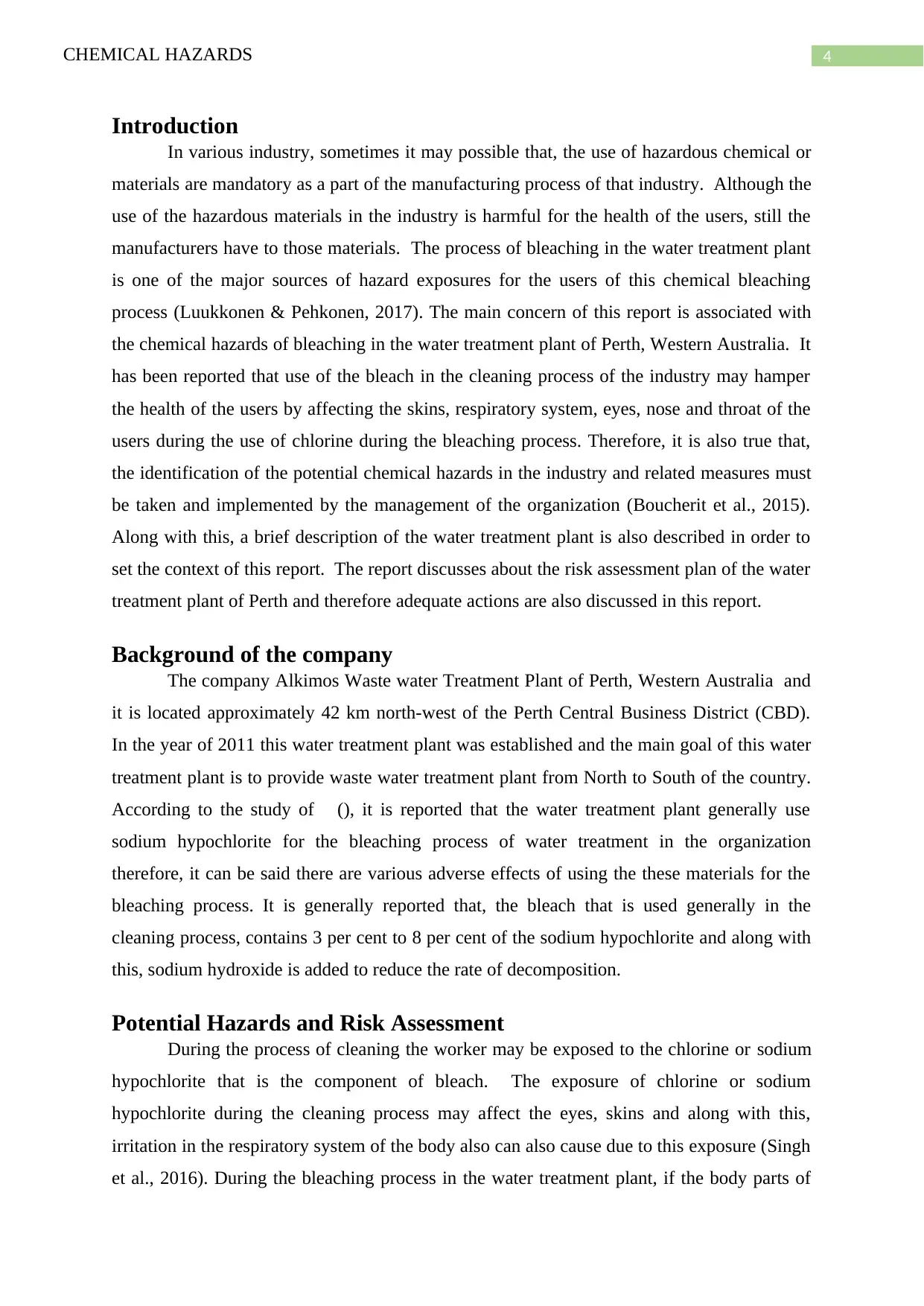
4CHEMICAL HAZARDS
Introduction
In various industry, sometimes it may possible that, the use of hazardous chemical or
materials are mandatory as a part of the manufacturing process of that industry. Although the
use of the hazardous materials in the industry is harmful for the health of the users, still the
manufacturers have to those materials. The process of bleaching in the water treatment plant
is one of the major sources of hazard exposures for the users of this chemical bleaching
process (Luukkonen & Pehkonen, 2017). The main concern of this report is associated with
the chemical hazards of bleaching in the water treatment plant of Perth, Western Australia. It
has been reported that use of the bleach in the cleaning process of the industry may hamper
the health of the users by affecting the skins, respiratory system, eyes, nose and throat of the
users during the use of chlorine during the bleaching process. Therefore, it is also true that,
the identification of the potential chemical hazards in the industry and related measures must
be taken and implemented by the management of the organization (Boucherit et al., 2015).
Along with this, a brief description of the water treatment plant is also described in order to
set the context of this report. The report discusses about the risk assessment plan of the water
treatment plant of Perth and therefore adequate actions are also discussed in this report.
Background of the company
The company Alkimos Waste water Treatment Plant of Perth, Western Australia and
it is located approximately 42 km north-west of the Perth Central Business District (CBD).
In the year of 2011 this water treatment plant was established and the main goal of this water
treatment plant is to provide waste water treatment plant from North to South of the country.
According to the study of (), it is reported that the water treatment plant generally use
sodium hypochlorite for the bleaching process of water treatment in the organization
therefore, it can be said there are various adverse effects of using the these materials for the
bleaching process. It is generally reported that, the bleach that is used generally in the
cleaning process, contains 3 per cent to 8 per cent of the sodium hypochlorite and along with
this, sodium hydroxide is added to reduce the rate of decomposition.
Potential Hazards and Risk Assessment
During the process of cleaning the worker may be exposed to the chlorine or sodium
hypochlorite that is the component of bleach. The exposure of chlorine or sodium
hypochlorite during the cleaning process may affect the eyes, skins and along with this,
irritation in the respiratory system of the body also can also cause due to this exposure (Singh
et al., 2016). During the bleaching process in the water treatment plant, if the body parts of
Introduction
In various industry, sometimes it may possible that, the use of hazardous chemical or
materials are mandatory as a part of the manufacturing process of that industry. Although the
use of the hazardous materials in the industry is harmful for the health of the users, still the
manufacturers have to those materials. The process of bleaching in the water treatment plant
is one of the major sources of hazard exposures for the users of this chemical bleaching
process (Luukkonen & Pehkonen, 2017). The main concern of this report is associated with
the chemical hazards of bleaching in the water treatment plant of Perth, Western Australia. It
has been reported that use of the bleach in the cleaning process of the industry may hamper
the health of the users by affecting the skins, respiratory system, eyes, nose and throat of the
users during the use of chlorine during the bleaching process. Therefore, it is also true that,
the identification of the potential chemical hazards in the industry and related measures must
be taken and implemented by the management of the organization (Boucherit et al., 2015).
Along with this, a brief description of the water treatment plant is also described in order to
set the context of this report. The report discusses about the risk assessment plan of the water
treatment plant of Perth and therefore adequate actions are also discussed in this report.
Background of the company
The company Alkimos Waste water Treatment Plant of Perth, Western Australia and
it is located approximately 42 km north-west of the Perth Central Business District (CBD).
In the year of 2011 this water treatment plant was established and the main goal of this water
treatment plant is to provide waste water treatment plant from North to South of the country.
According to the study of (), it is reported that the water treatment plant generally use
sodium hypochlorite for the bleaching process of water treatment in the organization
therefore, it can be said there are various adverse effects of using the these materials for the
bleaching process. It is generally reported that, the bleach that is used generally in the
cleaning process, contains 3 per cent to 8 per cent of the sodium hypochlorite and along with
this, sodium hydroxide is added to reduce the rate of decomposition.
Potential Hazards and Risk Assessment
During the process of cleaning the worker may be exposed to the chlorine or sodium
hypochlorite that is the component of bleach. The exposure of chlorine or sodium
hypochlorite during the cleaning process may affect the eyes, skins and along with this,
irritation in the respiratory system of the body also can also cause due to this exposure (Singh
et al., 2016). During the bleaching process in the water treatment plant, if the body parts of

5CHEMICAL HAZARDS
the human body containing mucous membrane are exposed to the chlorine or sodium
hypochlorite, then it can cause irritation to those areas and eyes, nose and throat of the users
as well. In the industry, the use of the chlorine in the bleaching process is one of the major
resources of the respiratory irritation cases in among the users of the bleach (Katnoria &
Sharma, 2020). Not only is this, in the water treatment plant, there a high chance of the
mixing the bleaching elements with other chemical and causes serious adverse incidents in
the water treatment plant (Manahan, S. E. (2017). For example, it can be said that in the water
treatment plant such incidents may happen due to accidents in case of a truck containing the
tank of acidic chemical collides with the sodium hypochlorite storages and thereby causes the
chlorine and sodium hypochlorite toxicity in the water treatment plant (Deshwal & Kundu,
2018). In a water treatment plant, acidic chemicals such as ferrous sulphate, ferric chloride,
ferric sulphate, ferrous chloride (pickle liquor), hydrochloric acid, sulphuric acid, aluminium
sulphate (alum), aluminium chloride, and phosphoric acid are generally used and they are
capable of producing toxic chemical substances while reacting with the sodium hypochlorite
(Aguiar et al., 2018). In the industrial system, the physical exposures to high amounts of
chlorine bleaching can is mostly associated with the respiratory problems among the users.
From the risk assessment table attached in Appendix 1, it can be reported that in the
water treatment plant, chemical hazards due to the use of the bleach during the cleaning
process is toxic and harmful in nature and it can cause allergic and corrosive effects to the
users. Apart from that, the risk assessment table also depicted that, the primary areas of
exposure are mainly the eyes, skin and inhalation of the bleaching components. Moreover, in
the treatment plant region, it is reported that, there are significant numbers of natural
ventilation process and all the users have proper training regarding the use of the chemicals in
the water treatment plant region.
Risk identification
Being aware of the bleach accident in the industrial facility, is pertinent to the control
measures being planned and applied in a workplace scenario. The important measures
indicators such as risk indicators include fading of clothes, choking and coughing, sudden
respiratory distress and the control process should begin immediately. The chlorine decay
should be controlled in the hydraulic and distribution systems and levels of residual chlorine
must be always checked. Other important measures includes checking the pH levels of water
and the temperature of water. The correct chlorination principles must be used.
the human body containing mucous membrane are exposed to the chlorine or sodium
hypochlorite, then it can cause irritation to those areas and eyes, nose and throat of the users
as well. In the industry, the use of the chlorine in the bleaching process is one of the major
resources of the respiratory irritation cases in among the users of the bleach (Katnoria &
Sharma, 2020). Not only is this, in the water treatment plant, there a high chance of the
mixing the bleaching elements with other chemical and causes serious adverse incidents in
the water treatment plant (Manahan, S. E. (2017). For example, it can be said that in the water
treatment plant such incidents may happen due to accidents in case of a truck containing the
tank of acidic chemical collides with the sodium hypochlorite storages and thereby causes the
chlorine and sodium hypochlorite toxicity in the water treatment plant (Deshwal & Kundu,
2018). In a water treatment plant, acidic chemicals such as ferrous sulphate, ferric chloride,
ferric sulphate, ferrous chloride (pickle liquor), hydrochloric acid, sulphuric acid, aluminium
sulphate (alum), aluminium chloride, and phosphoric acid are generally used and they are
capable of producing toxic chemical substances while reacting with the sodium hypochlorite
(Aguiar et al., 2018). In the industrial system, the physical exposures to high amounts of
chlorine bleaching can is mostly associated with the respiratory problems among the users.
From the risk assessment table attached in Appendix 1, it can be reported that in the
water treatment plant, chemical hazards due to the use of the bleach during the cleaning
process is toxic and harmful in nature and it can cause allergic and corrosive effects to the
users. Apart from that, the risk assessment table also depicted that, the primary areas of
exposure are mainly the eyes, skin and inhalation of the bleaching components. Moreover, in
the treatment plant region, it is reported that, there are significant numbers of natural
ventilation process and all the users have proper training regarding the use of the chemicals in
the water treatment plant region.
Risk identification
Being aware of the bleach accident in the industrial facility, is pertinent to the control
measures being planned and applied in a workplace scenario. The important measures
indicators such as risk indicators include fading of clothes, choking and coughing, sudden
respiratory distress and the control process should begin immediately. The chlorine decay
should be controlled in the hydraulic and distribution systems and levels of residual chlorine
must be always checked. Other important measures includes checking the pH levels of water
and the temperature of water. The correct chlorination principles must be used.
⊘ This is a preview!⊘
Do you want full access?
Subscribe today to unlock all pages.

Trusted by 1+ million students worldwide
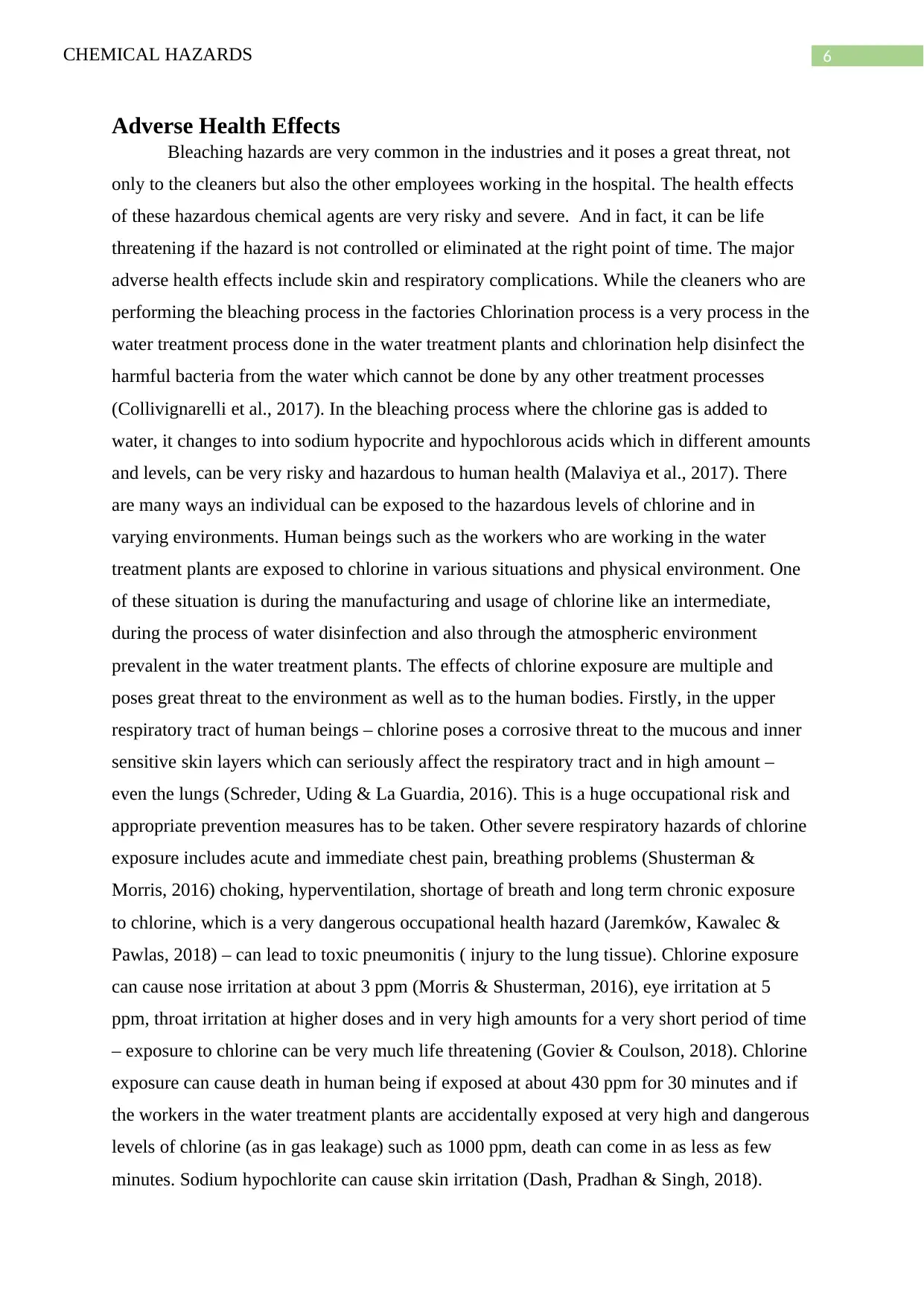
6CHEMICAL HAZARDS
Adverse Health Effects
Bleaching hazards are very common in the industries and it poses a great threat, not
only to the cleaners but also the other employees working in the hospital. The health effects
of these hazardous chemical agents are very risky and severe. And in fact, it can be life
threatening if the hazard is not controlled or eliminated at the right point of time. The major
adverse health effects include skin and respiratory complications. While the cleaners who are
performing the bleaching process in the factories Chlorination process is a very process in the
water treatment process done in the water treatment plants and chlorination help disinfect the
harmful bacteria from the water which cannot be done by any other treatment processes
(Collivignarelli et al., 2017). In the bleaching process where the chlorine gas is added to
water, it changes to into sodium hypocrite and hypochlorous acids which in different amounts
and levels, can be very risky and hazardous to human health (Malaviya et al., 2017). There
are many ways an individual can be exposed to the hazardous levels of chlorine and in
varying environments. Human beings such as the workers who are working in the water
treatment plants are exposed to chlorine in various situations and physical environment. One
of these situation is during the manufacturing and usage of chlorine like an intermediate,
during the process of water disinfection and also through the atmospheric environment
prevalent in the water treatment plants. The effects of chlorine exposure are multiple and
poses great threat to the environment as well as to the human bodies. Firstly, in the upper
respiratory tract of human beings – chlorine poses a corrosive threat to the mucous and inner
sensitive skin layers which can seriously affect the respiratory tract and in high amount –
even the lungs (Schreder, Uding & La Guardia, 2016). This is a huge occupational risk and
appropriate prevention measures has to be taken. Other severe respiratory hazards of chlorine
exposure includes acute and immediate chest pain, breathing problems (Shusterman &
Morris, 2016) choking, hyperventilation, shortage of breath and long term chronic exposure
to chlorine, which is a very dangerous occupational health hazard (Jaremków, Kawalec &
Pawlas, 2018) – can lead to toxic pneumonitis ( injury to the lung tissue). Chlorine exposure
can cause nose irritation at about 3 ppm (Morris & Shusterman, 2016), eye irritation at 5
ppm, throat irritation at higher doses and in very high amounts for a very short period of time
– exposure to chlorine can be very much life threatening (Govier & Coulson, 2018). Chlorine
exposure can cause death in human being if exposed at about 430 ppm for 30 minutes and if
the workers in the water treatment plants are accidentally exposed at very high and dangerous
levels of chlorine (as in gas leakage) such as 1000 ppm, death can come in as less as few
minutes. Sodium hypochlorite can cause skin irritation (Dash, Pradhan & Singh, 2018).
Adverse Health Effects
Bleaching hazards are very common in the industries and it poses a great threat, not
only to the cleaners but also the other employees working in the hospital. The health effects
of these hazardous chemical agents are very risky and severe. And in fact, it can be life
threatening if the hazard is not controlled or eliminated at the right point of time. The major
adverse health effects include skin and respiratory complications. While the cleaners who are
performing the bleaching process in the factories Chlorination process is a very process in the
water treatment process done in the water treatment plants and chlorination help disinfect the
harmful bacteria from the water which cannot be done by any other treatment processes
(Collivignarelli et al., 2017). In the bleaching process where the chlorine gas is added to
water, it changes to into sodium hypocrite and hypochlorous acids which in different amounts
and levels, can be very risky and hazardous to human health (Malaviya et al., 2017). There
are many ways an individual can be exposed to the hazardous levels of chlorine and in
varying environments. Human beings such as the workers who are working in the water
treatment plants are exposed to chlorine in various situations and physical environment. One
of these situation is during the manufacturing and usage of chlorine like an intermediate,
during the process of water disinfection and also through the atmospheric environment
prevalent in the water treatment plants. The effects of chlorine exposure are multiple and
poses great threat to the environment as well as to the human bodies. Firstly, in the upper
respiratory tract of human beings – chlorine poses a corrosive threat to the mucous and inner
sensitive skin layers which can seriously affect the respiratory tract and in high amount –
even the lungs (Schreder, Uding & La Guardia, 2016). This is a huge occupational risk and
appropriate prevention measures has to be taken. Other severe respiratory hazards of chlorine
exposure includes acute and immediate chest pain, breathing problems (Shusterman &
Morris, 2016) choking, hyperventilation, shortage of breath and long term chronic exposure
to chlorine, which is a very dangerous occupational health hazard (Jaremków, Kawalec &
Pawlas, 2018) – can lead to toxic pneumonitis ( injury to the lung tissue). Chlorine exposure
can cause nose irritation at about 3 ppm (Morris & Shusterman, 2016), eye irritation at 5
ppm, throat irritation at higher doses and in very high amounts for a very short period of time
– exposure to chlorine can be very much life threatening (Govier & Coulson, 2018). Chlorine
exposure can cause death in human being if exposed at about 430 ppm for 30 minutes and if
the workers in the water treatment plants are accidentally exposed at very high and dangerous
levels of chlorine (as in gas leakage) such as 1000 ppm, death can come in as less as few
minutes. Sodium hypochlorite can cause skin irritation (Dash, Pradhan & Singh, 2018).
Paraphrase This Document
Need a fresh take? Get an instant paraphrase of this document with our AI Paraphraser
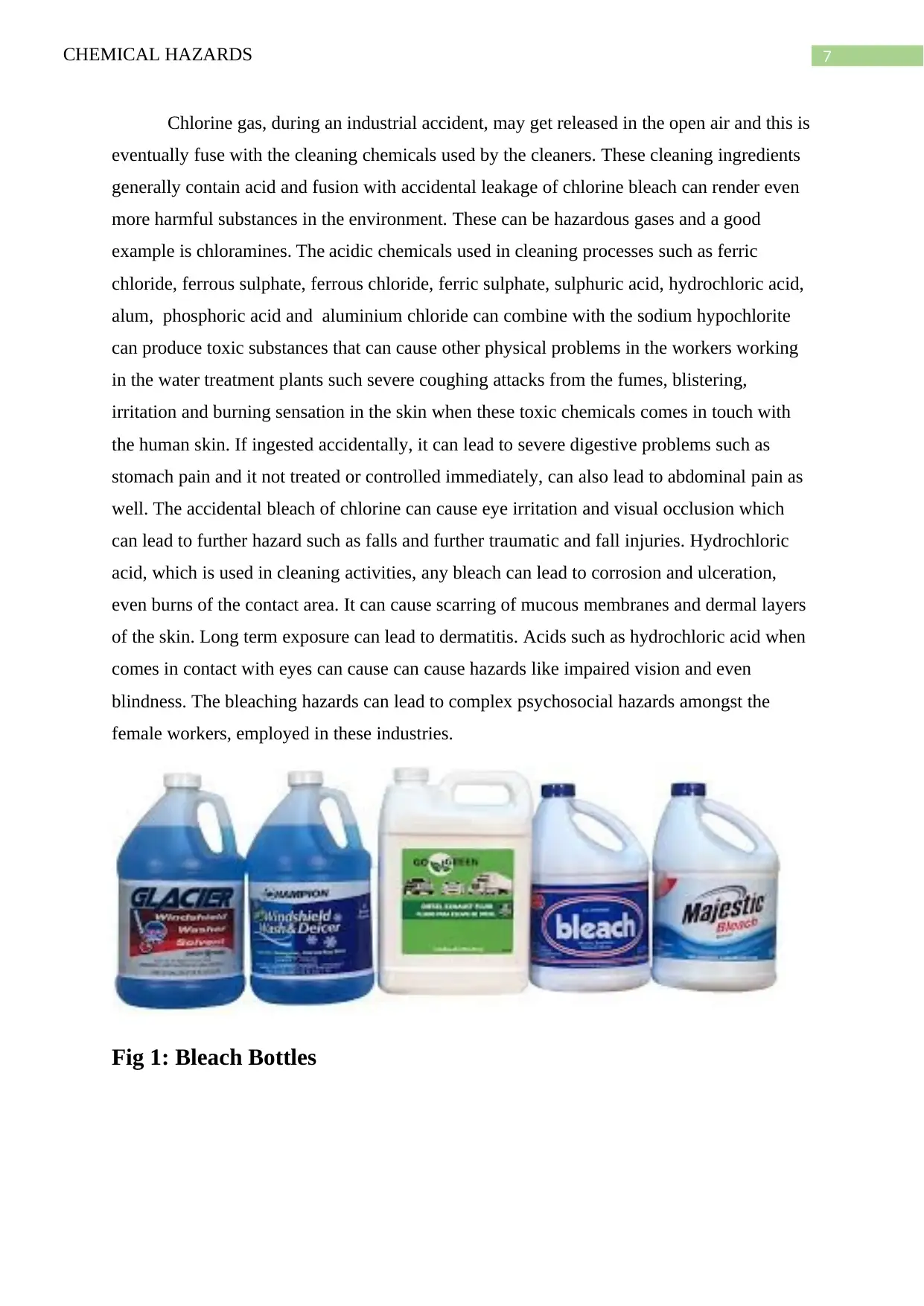
7CHEMICAL HAZARDS
Chlorine gas, during an industrial accident, may get released in the open air and this is
eventually fuse with the cleaning chemicals used by the cleaners. These cleaning ingredients
generally contain acid and fusion with accidental leakage of chlorine bleach can render even
more harmful substances in the environment. These can be hazardous gases and a good
example is chloramines. The acidic chemicals used in cleaning processes such as ferric
chloride, ferrous sulphate, ferrous chloride, ferric sulphate, sulphuric acid, hydrochloric acid,
alum, phosphoric acid and aluminium chloride can combine with the sodium hypochlorite
can produce toxic substances that can cause other physical problems in the workers working
in the water treatment plants such severe coughing attacks from the fumes, blistering,
irritation and burning sensation in the skin when these toxic chemicals comes in touch with
the human skin. If ingested accidentally, it can lead to severe digestive problems such as
stomach pain and it not treated or controlled immediately, can also lead to abdominal pain as
well. The accidental bleach of chlorine can cause eye irritation and visual occlusion which
can lead to further hazard such as falls and further traumatic and fall injuries. Hydrochloric
acid, which is used in cleaning activities, any bleach can lead to corrosion and ulceration,
even burns of the contact area. It can cause scarring of mucous membranes and dermal layers
of the skin. Long term exposure can lead to dermatitis. Acids such as hydrochloric acid when
comes in contact with eyes can cause can cause hazards like impaired vision and even
blindness. The bleaching hazards can lead to complex psychosocial hazards amongst the
female workers, employed in these industries.
Fig 1: Bleach Bottles
Chlorine gas, during an industrial accident, may get released in the open air and this is
eventually fuse with the cleaning chemicals used by the cleaners. These cleaning ingredients
generally contain acid and fusion with accidental leakage of chlorine bleach can render even
more harmful substances in the environment. These can be hazardous gases and a good
example is chloramines. The acidic chemicals used in cleaning processes such as ferric
chloride, ferrous sulphate, ferrous chloride, ferric sulphate, sulphuric acid, hydrochloric acid,
alum, phosphoric acid and aluminium chloride can combine with the sodium hypochlorite
can produce toxic substances that can cause other physical problems in the workers working
in the water treatment plants such severe coughing attacks from the fumes, blistering,
irritation and burning sensation in the skin when these toxic chemicals comes in touch with
the human skin. If ingested accidentally, it can lead to severe digestive problems such as
stomach pain and it not treated or controlled immediately, can also lead to abdominal pain as
well. The accidental bleach of chlorine can cause eye irritation and visual occlusion which
can lead to further hazard such as falls and further traumatic and fall injuries. Hydrochloric
acid, which is used in cleaning activities, any bleach can lead to corrosion and ulceration,
even burns of the contact area. It can cause scarring of mucous membranes and dermal layers
of the skin. Long term exposure can lead to dermatitis. Acids such as hydrochloric acid when
comes in contact with eyes can cause can cause hazards like impaired vision and even
blindness. The bleaching hazards can lead to complex psychosocial hazards amongst the
female workers, employed in these industries.
Fig 1: Bleach Bottles
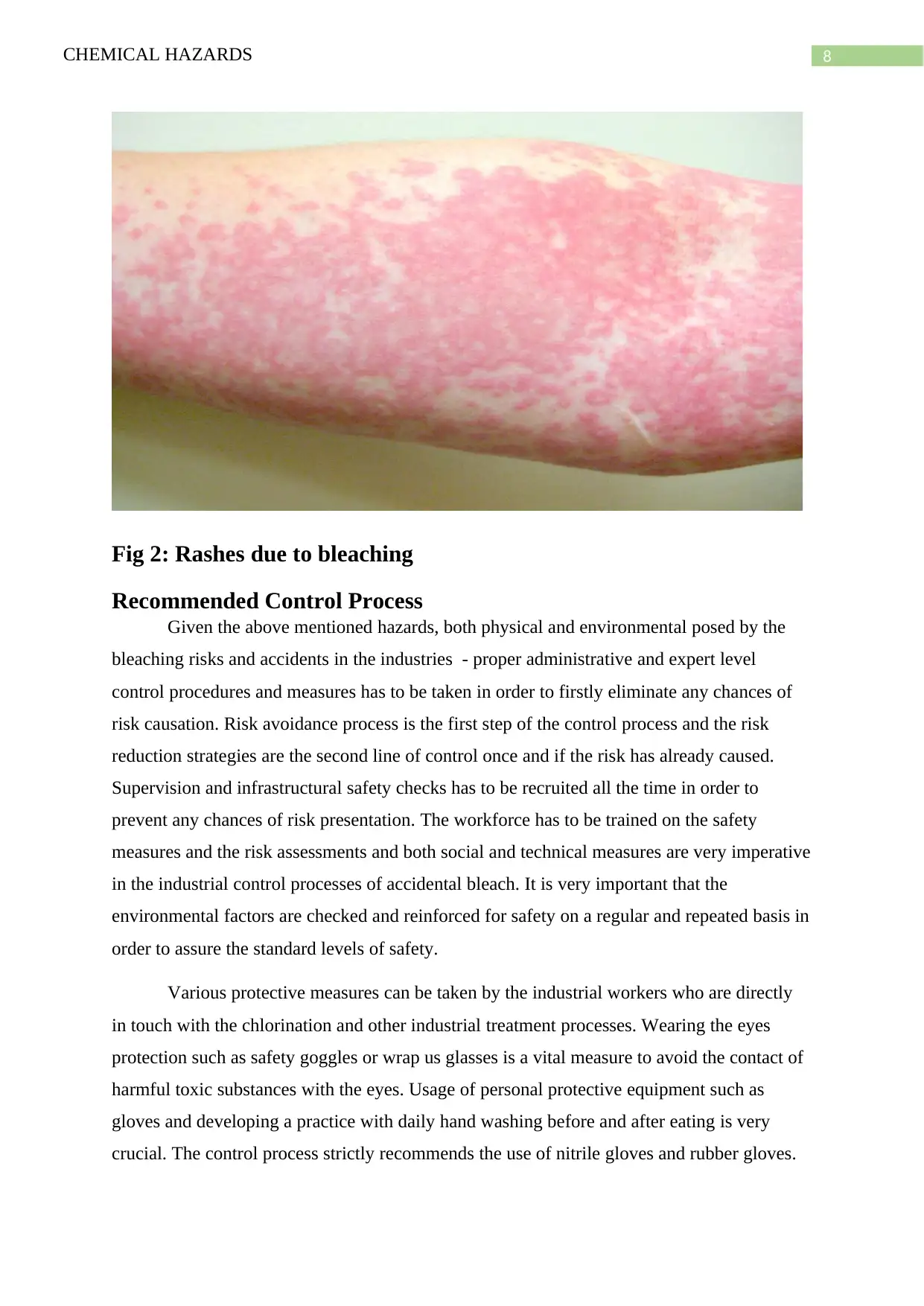
8CHEMICAL HAZARDS
Fig 2: Rashes due to bleaching
Recommended Control Process
Given the above mentioned hazards, both physical and environmental posed by the
bleaching risks and accidents in the industries - proper administrative and expert level
control procedures and measures has to be taken in order to firstly eliminate any chances of
risk causation. Risk avoidance process is the first step of the control process and the risk
reduction strategies are the second line of control once and if the risk has already caused.
Supervision and infrastructural safety checks has to be recruited all the time in order to
prevent any chances of risk presentation. The workforce has to be trained on the safety
measures and the risk assessments and both social and technical measures are very imperative
in the industrial control processes of accidental bleach. It is very important that the
environmental factors are checked and reinforced for safety on a regular and repeated basis in
order to assure the standard levels of safety.
Various protective measures can be taken by the industrial workers who are directly
in touch with the chlorination and other industrial treatment processes. Wearing the eyes
protection such as safety goggles or wrap us glasses is a vital measure to avoid the contact of
harmful toxic substances with the eyes. Usage of personal protective equipment such as
gloves and developing a practice with daily hand washing before and after eating is very
crucial. The control process strictly recommends the use of nitrile gloves and rubber gloves.
Fig 2: Rashes due to bleaching
Recommended Control Process
Given the above mentioned hazards, both physical and environmental posed by the
bleaching risks and accidents in the industries - proper administrative and expert level
control procedures and measures has to be taken in order to firstly eliminate any chances of
risk causation. Risk avoidance process is the first step of the control process and the risk
reduction strategies are the second line of control once and if the risk has already caused.
Supervision and infrastructural safety checks has to be recruited all the time in order to
prevent any chances of risk presentation. The workforce has to be trained on the safety
measures and the risk assessments and both social and technical measures are very imperative
in the industrial control processes of accidental bleach. It is very important that the
environmental factors are checked and reinforced for safety on a regular and repeated basis in
order to assure the standard levels of safety.
Various protective measures can be taken by the industrial workers who are directly
in touch with the chlorination and other industrial treatment processes. Wearing the eyes
protection such as safety goggles or wrap us glasses is a vital measure to avoid the contact of
harmful toxic substances with the eyes. Usage of personal protective equipment such as
gloves and developing a practice with daily hand washing before and after eating is very
crucial. The control process strictly recommends the use of nitrile gloves and rubber gloves.
⊘ This is a preview!⊘
Do you want full access?
Subscribe today to unlock all pages.

Trusted by 1+ million students worldwide

9CHEMICAL HAZARDS
Clothing is another important control measure and wearing a protective dress such as long
sleeves, closed buttons, tight pants, shoes and socks and chemical resistant aprons are critical
to ensure chemical and toxicity safety. In case of a bleach accident, the escape route of the
worker trapped inside play a useful role. Hence, the infrastructure of the industry or the
factory becomes imperative to the safety design and safety navigation for the workers. The
workplaces in the industries should be well ventilated and there should be a mix of multiple
doors so that there can be critical and risky reduction lockout process along with aiding the
workers find a safe exit out of the bleached area. Ventilation and oxygen cylinders must be
present in the facility and the medical team or rather the service shall be closely located to the
factory (Jiang, Yin & Kaynak, 2018). In order to prevent the chronic hazards that occurs due
to bleach, personal hygiene play an important part. Washing the body properly with soap and
taking shower twice a day, before and after the work is very necessary to prevent the
development of occupational health risks. The recommended and standardized chlorination
safety in the Alkimos Waste water treatment plant, Perth must include safe handling and
storage of chlorine, proper application chlorine liquid dosing systems, the right expert level
chlorine dose calculations and double checking the same, development of the standardized
operational procedure and training the workforce on the operational safety (Zhuang et al.,
2015). Finally, the factories should have a technology to monitor the chlorine level in the
environment and there should a proper alarm system to indicate the risky levels of chlorine in
the air (Gomez-Alvarez et al., 2016).
Implementation of the Recommendation
The implementation process of the planned control processes takes a great deal of
infrastructural support in addition to the human workforce contribution to safety guidelines
adherence. The Alkimos Waste water treatment plant in Perth can have a trained workforce to
handle the operational event in a very professional and risk safe way. The manager and the
supervisors working in Alkimos Waste water treatment plant in Perth should follow proactive
supervision and observational strategies to ensure the risk safe behaviours amongst the
employees working in the direct bleach operations, under them. Regular safety seminars and
trainings should be conducted in order to help the employees understand the implications of a
risk safe behaviours. The practical sessions should be conducted more often by the
supervisors in order to reduce the chances of chlorination bleach and the proper personal
protection policies must be embedded and encouraged in the organisational culture. The
proper industrial risk testing and monitoring has to be incorporated in the water treatment
Clothing is another important control measure and wearing a protective dress such as long
sleeves, closed buttons, tight pants, shoes and socks and chemical resistant aprons are critical
to ensure chemical and toxicity safety. In case of a bleach accident, the escape route of the
worker trapped inside play a useful role. Hence, the infrastructure of the industry or the
factory becomes imperative to the safety design and safety navigation for the workers. The
workplaces in the industries should be well ventilated and there should be a mix of multiple
doors so that there can be critical and risky reduction lockout process along with aiding the
workers find a safe exit out of the bleached area. Ventilation and oxygen cylinders must be
present in the facility and the medical team or rather the service shall be closely located to the
factory (Jiang, Yin & Kaynak, 2018). In order to prevent the chronic hazards that occurs due
to bleach, personal hygiene play an important part. Washing the body properly with soap and
taking shower twice a day, before and after the work is very necessary to prevent the
development of occupational health risks. The recommended and standardized chlorination
safety in the Alkimos Waste water treatment plant, Perth must include safe handling and
storage of chlorine, proper application chlorine liquid dosing systems, the right expert level
chlorine dose calculations and double checking the same, development of the standardized
operational procedure and training the workforce on the operational safety (Zhuang et al.,
2015). Finally, the factories should have a technology to monitor the chlorine level in the
environment and there should a proper alarm system to indicate the risky levels of chlorine in
the air (Gomez-Alvarez et al., 2016).
Implementation of the Recommendation
The implementation process of the planned control processes takes a great deal of
infrastructural support in addition to the human workforce contribution to safety guidelines
adherence. The Alkimos Waste water treatment plant in Perth can have a trained workforce to
handle the operational event in a very professional and risk safe way. The manager and the
supervisors working in Alkimos Waste water treatment plant in Perth should follow proactive
supervision and observational strategies to ensure the risk safe behaviours amongst the
employees working in the direct bleach operations, under them. Regular safety seminars and
trainings should be conducted in order to help the employees understand the implications of a
risk safe behaviours. The practical sessions should be conducted more often by the
supervisors in order to reduce the chances of chlorination bleach and the proper personal
protection policies must be embedded and encouraged in the organisational culture. The
proper industrial risk testing and monitoring has to be incorporated in the water treatment
Paraphrase This Document
Need a fresh take? Get an instant paraphrase of this document with our AI Paraphraser
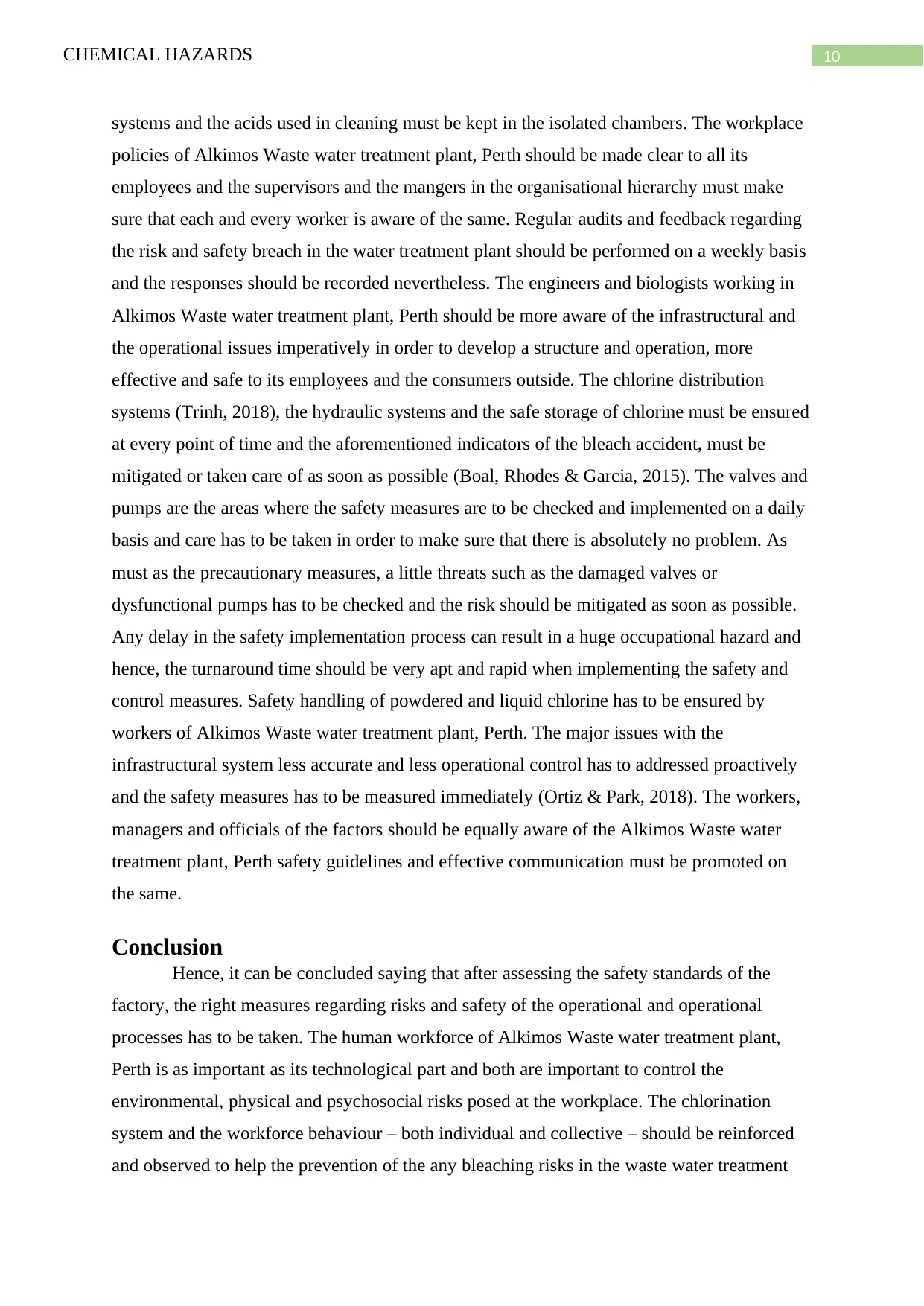
10CHEMICAL HAZARDS
systems and the acids used in cleaning must be kept in the isolated chambers. The workplace
policies of Alkimos Waste water treatment plant, Perth should be made clear to all its
employees and the supervisors and the mangers in the organisational hierarchy must make
sure that each and every worker is aware of the same. Regular audits and feedback regarding
the risk and safety breach in the water treatment plant should be performed on a weekly basis
and the responses should be recorded nevertheless. The engineers and biologists working in
Alkimos Waste water treatment plant, Perth should be more aware of the infrastructural and
the operational issues imperatively in order to develop a structure and operation, more
effective and safe to its employees and the consumers outside. The chlorine distribution
systems (Trinh, 2018), the hydraulic systems and the safe storage of chlorine must be ensured
at every point of time and the aforementioned indicators of the bleach accident, must be
mitigated or taken care of as soon as possible (Boal, Rhodes & Garcia, 2015). The valves and
pumps are the areas where the safety measures are to be checked and implemented on a daily
basis and care has to be taken in order to make sure that there is absolutely no problem. As
must as the precautionary measures, a little threats such as the damaged valves or
dysfunctional pumps has to be checked and the risk should be mitigated as soon as possible.
Any delay in the safety implementation process can result in a huge occupational hazard and
hence, the turnaround time should be very apt and rapid when implementing the safety and
control measures. Safety handling of powdered and liquid chlorine has to be ensured by
workers of Alkimos Waste water treatment plant, Perth. The major issues with the
infrastructural system less accurate and less operational control has to addressed proactively
and the safety measures has to be measured immediately (Ortiz & Park, 2018). The workers,
managers and officials of the factors should be equally aware of the Alkimos Waste water
treatment plant, Perth safety guidelines and effective communication must be promoted on
the same.
Conclusion
Hence, it can be concluded saying that after assessing the safety standards of the
factory, the right measures regarding risks and safety of the operational and operational
processes has to be taken. The human workforce of Alkimos Waste water treatment plant,
Perth is as important as its technological part and both are important to control the
environmental, physical and psychosocial risks posed at the workplace. The chlorination
system and the workforce behaviour – both individual and collective – should be reinforced
and observed to help the prevention of the any bleaching risks in the waste water treatment
systems and the acids used in cleaning must be kept in the isolated chambers. The workplace
policies of Alkimos Waste water treatment plant, Perth should be made clear to all its
employees and the supervisors and the mangers in the organisational hierarchy must make
sure that each and every worker is aware of the same. Regular audits and feedback regarding
the risk and safety breach in the water treatment plant should be performed on a weekly basis
and the responses should be recorded nevertheless. The engineers and biologists working in
Alkimos Waste water treatment plant, Perth should be more aware of the infrastructural and
the operational issues imperatively in order to develop a structure and operation, more
effective and safe to its employees and the consumers outside. The chlorine distribution
systems (Trinh, 2018), the hydraulic systems and the safe storage of chlorine must be ensured
at every point of time and the aforementioned indicators of the bleach accident, must be
mitigated or taken care of as soon as possible (Boal, Rhodes & Garcia, 2015). The valves and
pumps are the areas where the safety measures are to be checked and implemented on a daily
basis and care has to be taken in order to make sure that there is absolutely no problem. As
must as the precautionary measures, a little threats such as the damaged valves or
dysfunctional pumps has to be checked and the risk should be mitigated as soon as possible.
Any delay in the safety implementation process can result in a huge occupational hazard and
hence, the turnaround time should be very apt and rapid when implementing the safety and
control measures. Safety handling of powdered and liquid chlorine has to be ensured by
workers of Alkimos Waste water treatment plant, Perth. The major issues with the
infrastructural system less accurate and less operational control has to addressed proactively
and the safety measures has to be measured immediately (Ortiz & Park, 2018). The workers,
managers and officials of the factors should be equally aware of the Alkimos Waste water
treatment plant, Perth safety guidelines and effective communication must be promoted on
the same.
Conclusion
Hence, it can be concluded saying that after assessing the safety standards of the
factory, the right measures regarding risks and safety of the operational and operational
processes has to be taken. The human workforce of Alkimos Waste water treatment plant,
Perth is as important as its technological part and both are important to control the
environmental, physical and psychosocial risks posed at the workplace. The chlorination
system and the workforce behaviour – both individual and collective – should be reinforced
and observed to help the prevention of the any bleaching risks in the waste water treatment
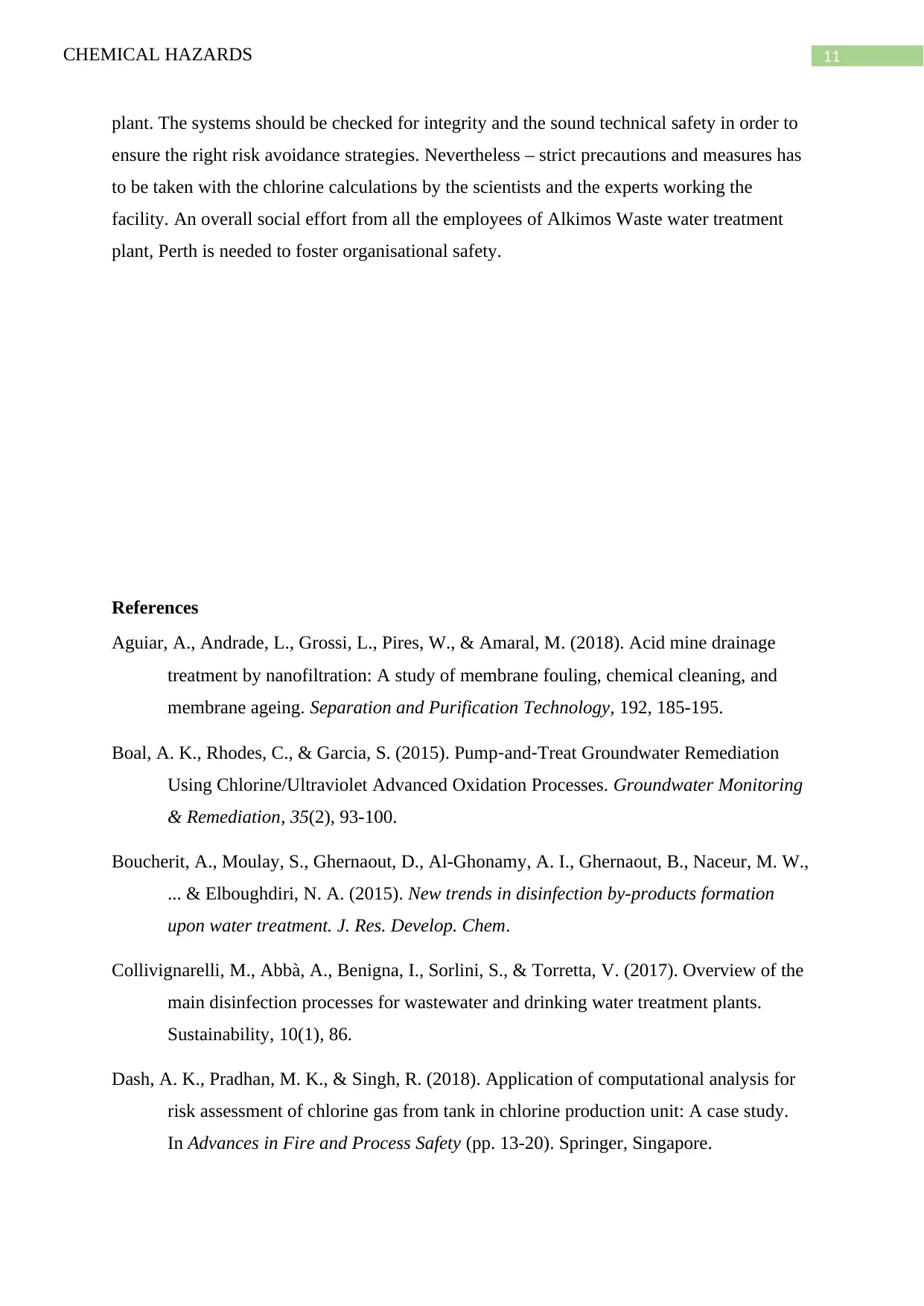
11CHEMICAL HAZARDS
plant. The systems should be checked for integrity and the sound technical safety in order to
ensure the right risk avoidance strategies. Nevertheless – strict precautions and measures has
to be taken with the chlorine calculations by the scientists and the experts working the
facility. An overall social effort from all the employees of Alkimos Waste water treatment
plant, Perth is needed to foster organisational safety.
References
Aguiar, A., Andrade, L., Grossi, L., Pires, W., & Amaral, M. (2018). Acid mine drainage
treatment by nanofiltration: A study of membrane fouling, chemical cleaning, and
membrane ageing. Separation and Purification Technology, 192, 185-195.
Boal, A. K., Rhodes, C., & Garcia, S. (2015). Pump‐and‐Treat Groundwater Remediation
Using Chlorine/Ultraviolet Advanced Oxidation Processes. Groundwater Monitoring
& Remediation, 35(2), 93-100.
Boucherit, A., Moulay, S., Ghernaout, D., Al-Ghonamy, A. I., Ghernaout, B., Naceur, M. W.,
... & Elboughdiri, N. A. (2015). New trends in disinfection by-products formation
upon water treatment. J. Res. Develop. Chem.
Collivignarelli, M., Abbà, A., Benigna, I., Sorlini, S., & Torretta, V. (2017). Overview of the
main disinfection processes for wastewater and drinking water treatment plants.
Sustainability, 10(1), 86.
Dash, A. K., Pradhan, M. K., & Singh, R. (2018). Application of computational analysis for
risk assessment of chlorine gas from tank in chlorine production unit: A case study.
In Advances in Fire and Process Safety (pp. 13-20). Springer, Singapore.
plant. The systems should be checked for integrity and the sound technical safety in order to
ensure the right risk avoidance strategies. Nevertheless – strict precautions and measures has
to be taken with the chlorine calculations by the scientists and the experts working the
facility. An overall social effort from all the employees of Alkimos Waste water treatment
plant, Perth is needed to foster organisational safety.
References
Aguiar, A., Andrade, L., Grossi, L., Pires, W., & Amaral, M. (2018). Acid mine drainage
treatment by nanofiltration: A study of membrane fouling, chemical cleaning, and
membrane ageing. Separation and Purification Technology, 192, 185-195.
Boal, A. K., Rhodes, C., & Garcia, S. (2015). Pump‐and‐Treat Groundwater Remediation
Using Chlorine/Ultraviolet Advanced Oxidation Processes. Groundwater Monitoring
& Remediation, 35(2), 93-100.
Boucherit, A., Moulay, S., Ghernaout, D., Al-Ghonamy, A. I., Ghernaout, B., Naceur, M. W.,
... & Elboughdiri, N. A. (2015). New trends in disinfection by-products formation
upon water treatment. J. Res. Develop. Chem.
Collivignarelli, M., Abbà, A., Benigna, I., Sorlini, S., & Torretta, V. (2017). Overview of the
main disinfection processes for wastewater and drinking water treatment plants.
Sustainability, 10(1), 86.
Dash, A. K., Pradhan, M. K., & Singh, R. (2018). Application of computational analysis for
risk assessment of chlorine gas from tank in chlorine production unit: A case study.
In Advances in Fire and Process Safety (pp. 13-20). Springer, Singapore.
⊘ This is a preview!⊘
Do you want full access?
Subscribe today to unlock all pages.

Trusted by 1+ million students worldwide
1 out of 14
Related Documents
Your All-in-One AI-Powered Toolkit for Academic Success.
+13062052269
info@desklib.com
Available 24*7 on WhatsApp / Email
![[object Object]](/_next/static/media/star-bottom.7253800d.svg)
Unlock your academic potential
Copyright © 2020–2025 A2Z Services. All Rights Reserved. Developed and managed by ZUCOL.





